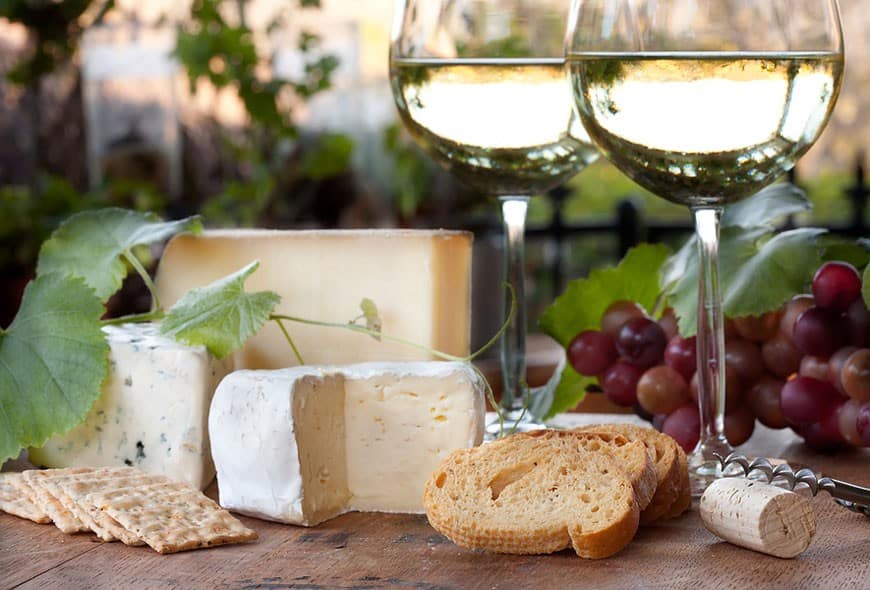The alluring combination of wine and cheese is a guaranteed way to delight and dazzle our taste palettes. However, it’s important to do a little research before throwing that wine and cheese social. Creamy, decadent cheeses tend to pair best with completely different tasting wines than sharp, tangy ones. Typically, young cheeses partner best with wines that are fresh, fruity, and spirited, like a crisp white or a dry rosé. Older cheeses pair well with wines that are more savory and rich.
Both wine and cheese are aspects of culture that are extremely telling of a country’s unique cuisine and tastes. Enrich your cultural insights by learning about the tastiest cheeses around the globe and the perfect wine accompaniment.
1. Brie
Brie is a soft, creamy cheese named after the region Brie in France. Brie has the nickname “The Queen of Cheeses,” and hundreds of years ago, Brie was one of the tributes paid to the French Kings. This cheese of royalty is soft and decadent, made from cow’s milk.
Brie is best paired with a rich white wine — a typical favorite being Chardonnay. Chardonnay is made from green-skinned grapes and is native to the Burgundy region of eastern France.
2. Feta
Feta is a tangy, crumbly cheese made from a combination of goat’s and sheep’s milk. It’s made with a brine solution, so its salty kick is no surprise. Feta, a traditional Greek cheese, is actually protected by EU legislations that state only those cheeses manufactured in Macedonia, Thessaly, Thrace, Central Mainland Greece, Lesvos and the Peloponnese can authentically be called “feta.” Many people envision feta as a crumbly dry cheese, but depending on its age, it can also be extremely creamy.
Feta’s unique taste matches best with Beaujolais, a French wine made of the Gamay grape which is low in tannins, an element that makes wine taste dry.
3. Chèvre
In French, Chèvre means “goat cheese,” clearly indicating that it’s made from goat’s milk. Goat cheeses are higher in Vitamin A and potassium than most other cheeses. They also contain less fat, making Chèvre a smart substitute for those working toward a healthier diet. Chèvre has a tart, earthy flavor that gives it a distinctive tang. There are various factors that determine the flavor and aroma of goat cheese: moisture, aging, density and flavoring.
The funky zest of goat cheese makes it a bit more difficult to pair with a wine. However, Sauvignon Blanc is the wine most often chosen to accompany Chèvre. The acidity in the wine matches the acidity in the cheese, creating a fresh and invigorating medley. Chèvre and Sauvignon Blanc are also regionally matched, both native to the Loire Valley in France.
4. Gouda
Gouda is a Dutch cheese named after the city of Gouda in the Netherlands. Gouda is actually one of the most popular cheeses in the world, accounting for about 50 percent of the world’s cheese consumption. It’s a semi-hard cheese typically made from pasteurized cow’s milk, but goat’s and sheep’s milk may be used in some varieties of Gouda. It has a rich, sweet, nutty flavor, which differs depending on the age of the cheese and whether it’s smoked.
Gouda’s strong taste is best accompanied by a wine that is deeply flavored, such as Merlot. Merlot is made from dark-blue colored grapes, namely from the Bordeaux wine regions in France.
5. Asiago
Asiago is an Italian cheese made from cow’s milk. It is exclusively produced on the Asiago plateau in the Veneto foothills of Italy. The cheese-making tradition in the Italian provinces of Trento and Vicenza began over a thousand years ago, and Asiago was traditionally made from sheep’s milk. There are two types of Asiago: fresh Asiago (Asiago Pressato) and aged Asiago (Asiago d’Allevo). The former has a smooth texture while the latter has a crumbly one.
As Asiago is a firm cheese with a stronger flavor, a fruity red like Zinfandel offers the perfect balance of acidity and tannin. Zinfandel, a word of uncertain origin, is made from a variety of black-skinned wine grapes native to Croatia. Usually, a hearty red wine is produced, but depending on the ripeness of the grapes, a semi-sweet blush rosé, White Zinfandel, can also be manufactured.
6. Gruyère
Gruyère is a traditional creamy, unpasteurized, semi-soft cheese made in Switzerland, named after the Swiss village, Gruyère. The mouth-watering cheese has a unique intricacy of flavors — starting with a fairly sweet taste but later tasting more earthy. The cheese itself is slightly grainy, with a natural brown rind pitted with tiny holes and a hard, yellow interior. It’s known as the go-to cheese for Swiss fondue.
Gruyère pairs up best with a crisp white wine due to its complex flavor. Vermentino is a wine made from light-skinned wine grapes primarily found in Italy. Vermentino is known to have a pine nut and basil aroma which best complements the herbal tones in Gruyère.
Though we all have different taste buds and may have our own personal preferences when it comes to pairing wine and cheese, there is somewhat of a science to it. Salt loves sweet. Sweet wines typically go best with the saltiest cheeses because the combinations heightens taste perception. Also, watch out for those tannins in wine. Tannins literally bind to protein and fat, so combining highly tannic wines with young cheeses usually result in a dull, metallic aftertaste.
Wine and cheese have gone hand in hand for past generations and will continue for generations to come. Rest assured that you don’t have to be a cheese expert or a wine connoisseur to treat your taste buds to a rich, cultural experience.


